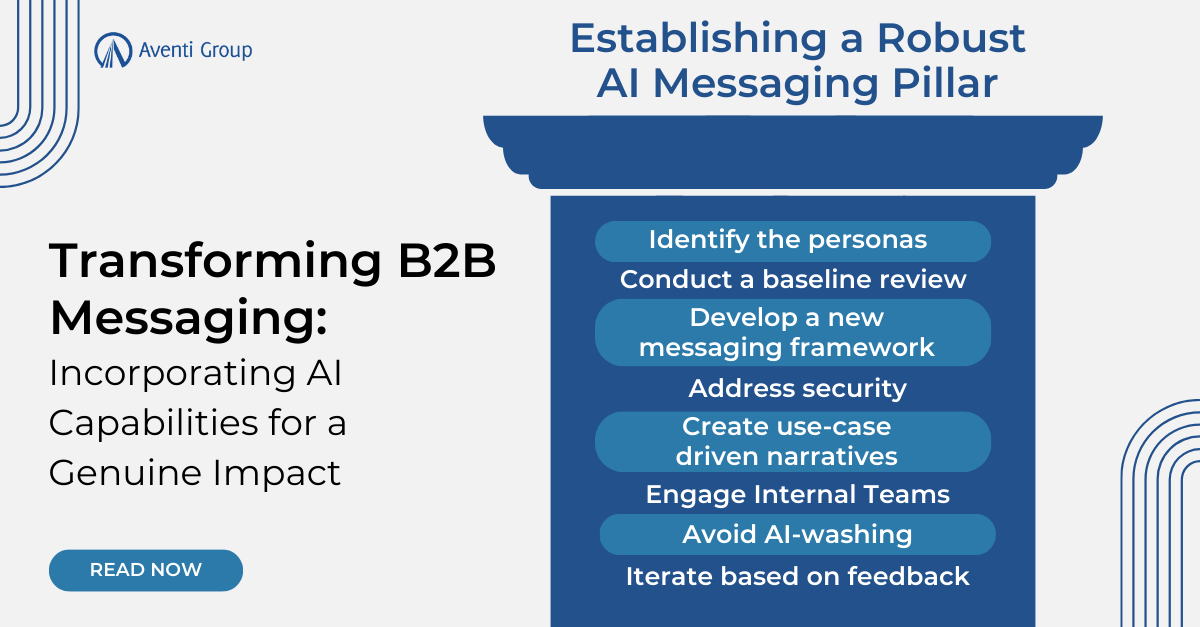Transforming B2B Messaging: Incorporating AI Capabilities for a Genuine Impact
Creating Authentic AI Messaging: A Guide to Showcasing Real Value
In today’s fast-evolving business landscape, AI has become more than just a buzzword––it’s a narrative every organization is keen to share. But as with the earlier wave of “Cloud-washing” we saw in B2B messaging, a common pitfall many companies fall into is the “us too” bandwagon surrounding AI, aka “AI-washing.”
Particularly in the B2B domain, where the audience is constantly inundated with claims of AI-driven transformations, it is becoming more and more critical to craft authentic messaging around your AI offerings that resonate with your audience. The key question to ask here is the same as with any new offering: where is your value add, and how is your AI integration revolutionizing the way people work?
Following this line of thought, we thought it would be helpful to delve into a couple of real-world applications where AI messaging has been seamlessly integrated to resonate with the target audience. We will spotlight two anonymized case studies from our clientele at Aventi Group that illustrate how authentic AI messaging can be crafted and conveyed. Through these practical examples, along with further best practices shared in this article, we aim to provide a richer understanding of how to integrate AI capabilities into your messaging in an authentic, meaningful way.

Embracing AI for Real-Time Fraud Detection
Company 1, traditionally a database management organization, recognized that incorporating AI into their offering would allow them to stay competitive in their domain. The main challenge they faced was cumbersome data storage, which made it difficult to parse relationships among data in real-time––for example, to detect fraud on a credit card. Under their previous system, by the time a red flag went up, it was already too late to catch the fraudster.
The integration of AI facilitated a more nuanced, web-like data connection, replacing the existing linear data analysis methods. This web of data connections enabled Company 1 to do real-time analysis, making fraud detection not just faster but significantly more accurate.
In this case, AI didn’t just add a layer to the existing system; it transformed the core of how Company 1 approached fraud detection. This is a great example of how AI can make a real difference in operations and efficiency, paving the way toward real-time, actionable insights that substantially mitigate risks. For this company, reworking their messaging to highlight the enhanced fraud detection capabilities fostered by AI integration is crucial, showcasing not only their technological innovation but also the tangible benefits brought to the table for customers and employees alike.
Enhancing Project Prioritization with AI Analytics
Company 2 is a business intelligence entity that wanted to extend its capabilities beyond just high-priority projects. They embraced AI to better utilize their data, which was often confined to the more resource-intensive systems, leaving smaller projects unattended due to a lack of resources. The existing setup served high-priority projects well, but often left regular users and smaller projects in a lurch, necessitating a more democratic approach to data analytics.
With the introduction of Company 2’s AI offering, which featured a user-friendly interface resembling Excel, AI analytics became accessible to a wider user base within the company. This was about supplementing existing systems with AI rather than replacing them.
This case illustrates how AI can be seamlessly integrated to supplement existing processes, delivering more value, and ensuring that resources are utilized optimally across the board––not just for high-priority tasks. Reworking messaging to accentuate this democratization of data analytics, the support to underserved customers, and the subsequent operational enhancements can significantly resonate with prospects, highlighting the tangible benefits and the expanded scope of project execution enabled by their AI offering.
Navigating the New Security Landscape
The integration of Artificial Intelligence (AI) within business operations doesn’t just alter functionality but also introduces a new spectrum of security concerns. The challenge here is to ensure data privacy and protection, especially when training AI models with sensitive or proprietary information. This data, once part of the AI model, can potentially become a vulnerability if not handled with meticulous security measures. So, in shaping the narrative around your AI capabilities, proactively addressing security concerns is not only prudent but essential to instilling trust and confidence in your audience.
Moreover, the advent of AI presents a two-fold challenge: safeguarding the data utilized by AI models, and ensuring the AI system itself is secure from adversarial attacks. Adversarial attacks are crafted inputs that exploit the way AI models learn, causing them to make incorrect decisions. These adversarial vulnerabilities necessitate a new approach to security that encompasses robust validation and monitoring of AI systems to ensure they function as intended even in the face of malicious input.
Furthermore, the potential for AI to autonomously interact with systems and make decisions escalates the stakes. Ensuring robust security protocols to mitigate risks associated with unauthorized access or malicious manipulation of AI systems is crucial.
The above concerns accentuate the need for a comprehensive security strategy encompassing not just traditional security measures, but also new solutions tailored to the unique challenges posed by AI integration. This strategy should be conveyed clearly in your messaging to provide assurance to prospects that while your product leverages the power of AI to drive transformation, it does so without compromising on security.
Transparent communication about how your product addresses these security challenges while articulating the steps taken to ensure data protection and system integrity, will not only foster trust but also establish a solid foundation for engaging with informed and security-conscious prospects. It’s about striking the balance between innovation and security, ensuring that while your product propels businesses forward, it also steadfastly guards against the new genre of threats in the digital landscape.
Distinguishing Between AI and ML in Messaging
When reworking your messaging to include an AI offering, it’s essential to ensure a precise and authentic representation of your product’s capabilities. When delving into the realms of Artificial Intelligence (AI) and Machine Learning (ML), the distinction becomes crucial. AI encompasses a broader spectrum of capabilities including, but not limited to, ML. Therefore, when messaging about AI, it’s imperative to ensure that the functionalities marketed as AI are indeed reflective of true AI capabilities and not merely ML components masquerading as AI.
For instance, if your product employs advanced natural language understanding to facilitate nuanced interactions and decision-making akin to human reasoning, that’s a bona fide AI feature. Conversely, if it utilizes algorithms such as SVM, k-means, or Holt-Winters to learn from data and make predictions or recommendations, that’s fundamentally ML.
By ensuring that the messaging accurately represents the AI and ML functionalities, businesses can uphold authenticity, which in turn resonates with informed prospects seeking real transformative value. This approach not only elevates your trust and credibility factor but also aligns with the discerning needs of prospects, thereby creating a narrative that’s both genuine and value-driven. Such authentic representation makes sure your messaging is rooted in reality and reflective of the actual value your product brings to the table.
Establishing a Robust AI Messaging Pillar
In an era where many businesses are enthusiastically diving onto the AI bandwagon, the real differentiator is not just the adoption of AI, but the clear and genuine portrayal of its capabilities. The insights from Company 1 and Company 2 serve as a testament to the transformative potential of AI when applied effectively and authentically. The case studies underscore the paramount importance of aligning your messaging with the true capabilities of your product.
Here’s a step-by-step guide on how to proceed with integrating your AI capabilities into your messaging:
Identify the personas:
Determine personas for the various stakeholders who interact with or are impacted by your AI product. This could range from data engineering teams and IT professionals to the end users who leverage AI-driven insights for decision-making.
Conduct a baseline review:
Engage with product developers, your data engineering team, or even API developers to understand the full scope and capacity capability of your AI functionalities. (And again, it’s critical here to underscore the tangible functionality of those capabilities rather than focusing on the aspects that might excite the data engineering team.) Review existing messaging to identify which aspects remain valid and which need reiteration or modification to include the new AI features.
Develop a new messaging framework:
Center your messaging framework around the “real transformative value” of your AI offering as illustrated in the case studies. It’s about how your product changes the work paradigm, aids underserved users, and elevates the functionality of existing systems.
Address security:
With AI integration, new security concerns surface. Ensure your messaging tackles the measures taken to ensure data privacy and system integrity, aligning with the security-conscious mindset of your prospects.
Create use-case driven narratives:
Craft narratives around specific use cases that reflect the real-world impact and the transformative value of your AI offerings.
Engage internal teams:
Make sure your internal teams are well-aligned with the new messaging. Conduct workshops or informational sessions to disseminate the revamped messaging, ensuring a cohesive external communication strategy.
Avoid AI-washing:
Authentically represent the AI and ML functionalities in your messaging to avoid falling into the trap of AI-washing. Make it clear when a feature is driven by AI or ML and the tangible benefits thereof.
Iterate based on feedback:
As your AI product evolves and as you receive feedback from your audience, be ready to iterate your messaging to keep it accurate, relevant, and resonant.
By adhering to these steps, you set the stage for a compelling narrative that not only communicates the true essence of your AI offering but also resonates deeply with your prospects, establishing a clear value proposition that sets you apart in a crowded market. This new messaging pillar serves as a robust foundation for engaging with your prospects, armed with a genuine and value-driven narrative that articulates the transformative potential of your AI solutions.
Forging Authentic AI Narratives
The journey toward AI transformation is more than a technological shift; it’s a narrative that exemplifies innovation, customer-centricity, and opportunities for authentic value-add. As you maneuver through the buzz of AI claims in the B2B sphere, grounding your messaging in the real transformative value of AI will not only set you apart but will also resonate deeply with your prospects.
The case studies of Company 1 and Company 2 underscore the tangible benefits and the real transformative value that AI can bring to the table when applied judiciously and communicated transparently. It’s not about hopping onto the AI bandwagon hastily but about meticulously integrating AI where it truly amplifies capabilities, solves real challenges, and brings discernible advantages to your customers.
In this vein, having a solid, authentic narrative around your AI offerings is paramount. Ensuring that your messaging accurately reflects the true capabilities of your AI and ML technologies, and addressing the accompanying security concerns head-on, are essential steps in building trust and engagement with your target audience.
A special thank you to Aventi Group consultants Dan Janzen and Tom Yates, who lent their expertise and insights to this piece. Your contributions were invaluable and greatly appreciated.
Ready to craft a compelling narrative for your AI-powered offerings? A solid messaging strategy is pivotal in distinguishing your solutions in a crowded marketplace. At Aventi Group, we specialize in ensuring that your AI messaging resonates with the right audience and delivers authentic value. Connect with us to revamp your messaging, showcase the true transformative value of your AI capabilities, and accelerate your market traction.




